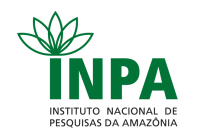Corpo Discente - Egressos
Oberdan Oliveira Ferreira
| Título | ESTUDO QUÍMICO E BIOLÓGICO DOS ÓLEOS ESSENCIAIS DE ESPÉCIES DE Myrcia e Eugenia (MYRTACEAE) COM OCORRÊNCIA NA MICRORREGIÃO DO SALGADO, NORDESTE PARAENSE | ||||||||||||||||||||||||
| Data da Defesa | 17/01/2022 | ||||||||||||||||||||||||
| Download | Visualizar a Tese(6.67MB) | ||||||||||||||||||||||||
Banca
| |||||||||||||||||||||||||
| Palavras-Chaves | Produtos naturais; Compostos voláteis; Capacidade antioxidante; Potencial antifúngico. | ||||||||||||||||||||||||
| Resumo | Myrtaceae é considerada uma das principais famílias botânicas com espécies produtoras de óleos essenciais. Dentro desta família há dois gêneros que possuem grande destaque, que são Myrcia e Eugenia. Em virtude da grande representatividade desses dois gêneros, o referido estudo teve como objetivo avaliar a composição química, bem como determinar a capacidade antioxidante e o potencial antifúngico presente nos óleos essenciais de Myrcia e Eugenia. As amostras utilizadas nesta tese foram registradas no Sistema Nacional de Gestão do PatrimônioGenético e do Conhecimento Tradicional Associado (SISGEN) com o número de cadastro: A6B3571. Inicialmente foi realizada uma revisão da literatura das espécies de Myrtaceae, no qual foi abordada a composição química, atividades antifúngicas e atividades antibacterianas. Os óleos essenciais dos espécimes (A e B) de Myrcia eximia, M. multiflora (A, B e C) e Eugenia florida (A e B) foram extraídos por hidrodestilação, e o espécime B de M. eximia por destilação a vapor (AV), e a composição química dos óleos essenciais foi analisada por cromatografia gasosa acoplada à espectrometria de massas (CGEM). A atividade antioxidante foi determinada por meio de ensaios da capacidade antioxidante pela redução do radical difenilpicril-hidrazil (CA-DPPH) e pela capacidade antioxidante equivalente de trolox (TEAC). Os rendimentos dos óleos essenciais foram calculados de acordo com a Base Livrede Umidade (BLU). Pelos métodos de disco-difusão em ágar e microdiluição em caldo (CIM) e (CFM), foi avaliado o potencial fungicida dos óleos essenciais contra cinco leveduras fungicas: Candida albicans INCQS - 40175, C. tropicalis ATCC 6258, C. famata ATCC 62894, C. krusei ATCC 13803, e C. auris IEC-01. Os rendimentos dos oléos essenciais variaram de 0,01 - 0,98 (v/w %). O óleo essencial de Myrcia eximia foi fortemente caracterizado pelos compostos: Hexanal (26,09%) e (E)- cariofileno (15- 20%). O perfil químico dos óleos essenciais dos espécimes (A e B) de Eugenia florida foi caracterizado respectivamente por limoneno (11,98%) e selina-3,11-dien6-ol (12,03%), por sua vez, os óleos essenciais dos espécimes (A, B e C) de Myrcia multiflora apresentaram os respectivos compostos majoritários: -bulneseno (26,79%), (E)- nerolidol (44,4%) e (92,21%). Os óleos essenciais dos espécimes (A e B) de E. florida apresentaram, respectivamente, potencial antioxidante de (172%) e (214%) no DPPH, sendo que em ambos esta atividade foi superiorao padrão trolox. Em contrapartida, no TEAC estes percentuais foram inferiores ao padrão com 0,456% (espécime A) e 0,652% (espécime B). As espécies fúngicas foram sensíveis perante o óleo essencial de M. multiflora (B) (9-11mm), e a menor concentração inibitória (0,07%) foi observado no óleo essencial de M. multiflora (A) contra as leveduras de C. famata. A ação fungicida foi observada nos óleos essenciais de M. multiflora (A) e (C), contra C. albicans, C. famata e C. krusei. Os resultados encontrados neste estudo são promissores ao desenvolvimento tanto de antioxidantes naturais, quanto de fungicidas. No entanto, são necessários novos estudos para comprovar a eficácia e efetividade desses óleos essenciais. | ||||||||||||||||||||||||
| Abstract | Myrtaceae is considered one of the main botanical families with species that produce essentialoils. Within this family there are two genera that have great prominence, which are Myrcia and Eugenia. Due to the great representation of these two genera, this study aimed to evaluate the chemical composition, as well as to determine the antioxidant capacity and the antifungal potential present in the essential oils of Myrcia and Eugenia. The samples used in this thesis were registered in the National System for the Management of Genetic Heritage and Associated Traditional Knowledge (SISGEN) with the registration number: A6B3571. Initially, a literature review of Myrtaceae species was carried out, in which the chemical composition, antifungal activities and antibacterial activities were addressed. The essential oils of specimens (A and B) of Myrcia eximia, M. multiflora (A, B and C) and Eugenia florida (A and B) were extracted by hydrodistillation (HD), and specimen B of M. eximia by steam distillation (AV), and the chemical composition of the essential oils was analyzed by gas chromatography coupled with mass spectrometry (GC-MS). Antioxidant activity was determined by means of antioxidant capacity assays by diphenylpicrylhydrazyl radical reduction (CA-DPPH) and by trolox equivalent antioxidant capacity (TEAC). The essential oil yields were calculated according to the Moisture Free Base (BLU). Using agar disk diffusion and broth microdilution (CIM) and (CFM) methods, the fungicidal potential of essential oils against five fungal yeasts was evaluated: Candida albicans INCQS - 40175, C. tropicalis ATCC 6258, C. famata ATCC 62894, C. krusei ATCC 13803, and C. auris IEC-01. The essential oil yields ranged from 0.01 - 0.98 (v/w %). Myrcia eximia essential oil was strongly characterized by the compounds: Hexanal (26.09%) and (E)-caryophyllene (15- 20%). The chemical profile of the essential oils of specimens (A and B) of Eugenia florida was characterized respectively by limonene (11.98%) and seline-3,11-dien-6α-ol (12.03%), in turn, the essential oils of specimens (A, B and C) of Myrcia multiflora showed the respective major compounds: α-bulnesene (26.79%), (E)-nerolidol (44.4%) and (92.21%). The essential oils of specimens (A and B) of E. florida showed, respectively, antioxidant potential of (172%) and (214%) in DPPH, and in both this activity was superior to the trolox standard. On the other hand, in TEAC these percentages were lower than the standard with 0.456% (specimen A) and 0.652% (specimen B). The fungal species were sensitive to the essential oil of M. multiflora (B) (9-11mm), and the lowest inhibitory concentration (0.07%) was observed in the essential oil of M. multiflora (A) against the yeasts of C. famata. The fungicidal action was observed in the essential oils of M. multiflora (A) and (C), against C. albicans, C. famata and C. krusei. The results found in this study are promising for the development of both natural antioxidants and fungicides. However, further studies are needed to prove the efficacy and effectiveness of these essential oils. | ||||||||||||||||||||||||
Parceiros

























